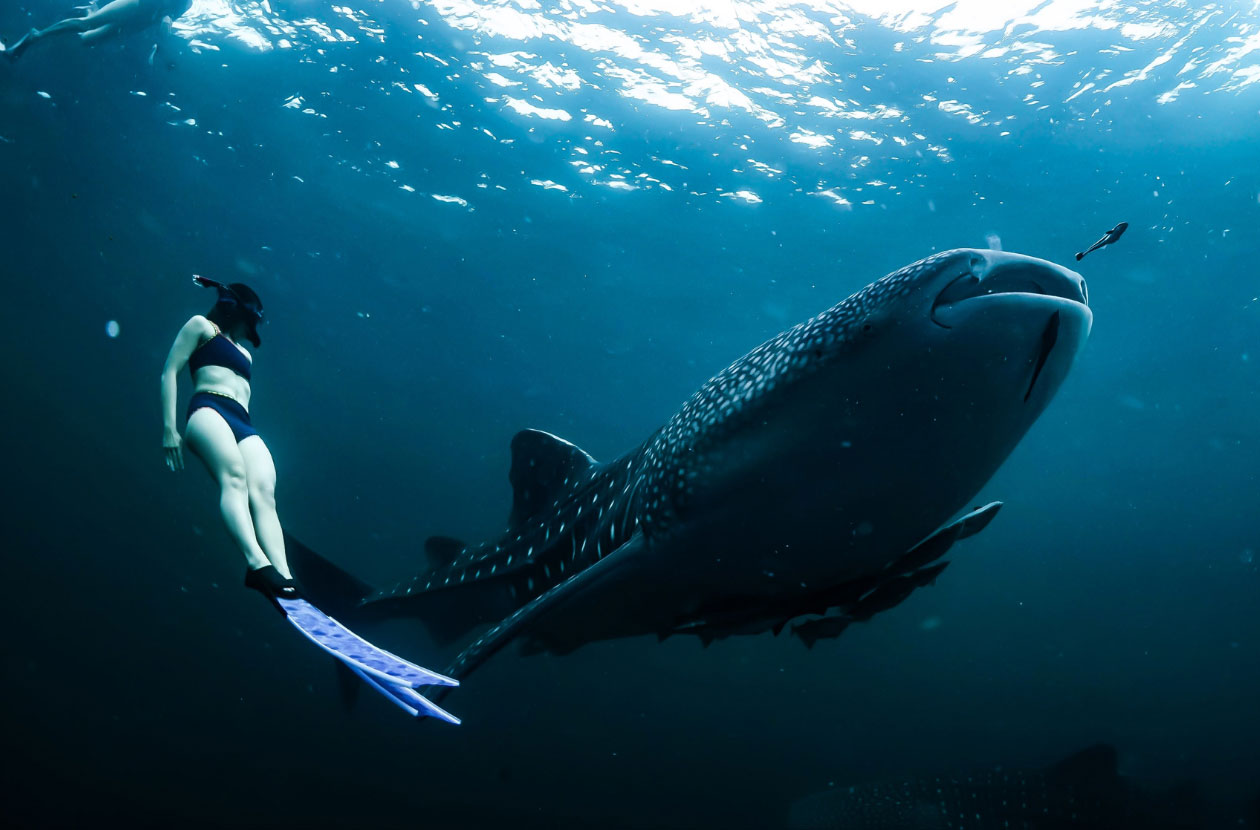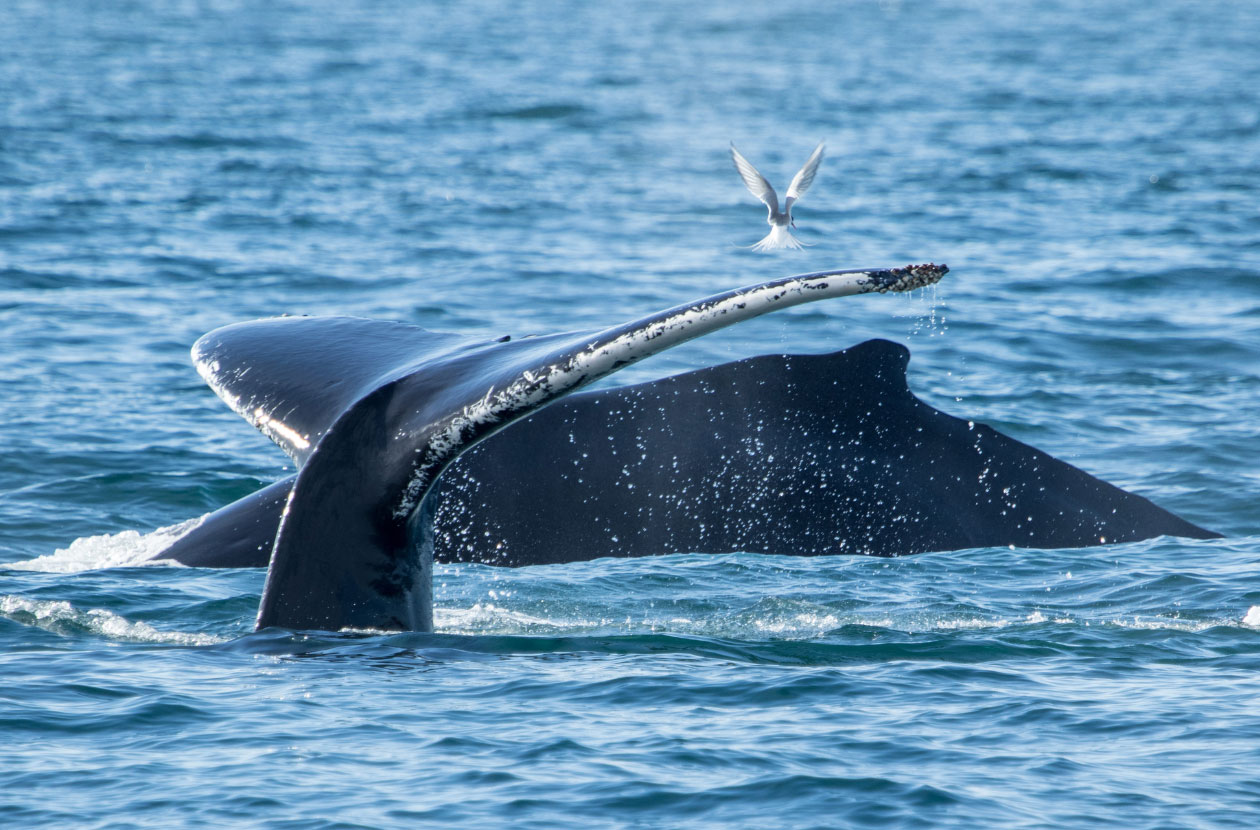Swimming with whales is certainly a wonderful thing and an amazing experience. However, is swimming with whales allowed? And if so, what are the safety rules for you and for these large animals? Today we will talk about whales and swimming with them.
Encountering whales and other large creatures while swimming is a significant factor in promoting marine conservation. In essence, marine megafauna hold greater value as live attractions for tourists than as a food. Regrettably, the reality is straightforward: by shifting the perception of sharks, manta rays, and other sizable species from “food” to “entertainment,” we can prevent the excessive killing of these animals. So where and how can you swim with whales?
Swimming with Whales
Plunging into the immensity of the ocean and encountering the awe-inspiring presence of whales is a life-changing experience. Imagine floating effortlessly in the crystal clear waters, feeling a deep connection with these magnificent creatures. Swimming with whales offers a unique opportunity to witness the magnificence of nature and become an advocate for marine conservation.
This transformative experience also extends to other large marine animals, such as sharks and manta rays. These creatures, often misunderstood and feared, can change the hearts and minds of those who encounter them up close. When we see them not as threats but as mesmerizing beings in their natural habitat, we begin to challenge preconceived notions and advocate for their preservation.
What is it like to swim with whales?
Swimming with whales is a truly remarkable and humbling experience that goes beyond words. It’s an immersive journey into the realm of these magnificent creatures, where time seems to stand still and the boundaries between humans and marine life blur. As you enter the water, anticipation and excitement fill the air. The first glimpse of a whale’s majestic presence is enough to take your breath away. The sheer size and strength of these gentle giants become apparent as they gracefully glide through the water, exuding a sense of calm.

The water envelops you and its cool touch heightens your senses. You feel weightless as you watch the whales’ movements, their streamlined bodies moving effortlessly through the depths. The sound of their melodious songs reverberates through the water, creating an unearthly symphony that captivates the soul.
Approaching these magnificent creatures requires respect and caution. The key is to keep a safe distance and observe them from a respectful place. However, there are instances where curiosity and trust lead to intimate encounters. A whale may curiously approach you, acknowledging your presence with a gentle glance, as if confirming the common bond between different species.
What whale can you swim with?
There are various species of whales that can be encountered and, in some cases, swum with, depending on the location and local regulations. Here are a few examples of whale species that people commonly have the opportunity to swim with:
- Humpback Whales: Humpback whales are known for their acrobatic displays, breaching, and majestic songs. They are found in several locations around the world, including Hawaii, Tonga, Mexico, and certain areas in Australia and Alaska. Some regions offer carefully regulated opportunities to swim alongside humpback whales during their migratory journeys.
- Whale Sharks: Despite their name, whale sharks are not actually whales but rather the largest species of sharks. They are gentle filter feeders and are considered safe to swim with. Popular destinations for swimming with whale sharks include Mexico (Isla Holbox, Isla Mujeres), the Philippines (Donsol), the Maldives, and Ningaloo Reef in Western Australia.
- Orcas (Killer Whales): Orcas are highly intelligent and social creatures, often sought after for their impressive displays and hunting strategies. In certain regions, such as Norway, British Columbia, and New Zealand, there are opportunities to swim with orcas while adhering to strict guidelines and under the supervision of experienced guides.
It is important to note that swimming with whales is typically done under controlled conditions with experienced guides and operators who prioritize the safety and well-being of both humans and the marine animals. Regulations and guidelines may vary in different locations to ensure minimal disturbance to the whales and their natural behavior.
Always research and choose reputable and responsible tour operators who follow sustainable and ethical practices. Respecting the animals’ space, following local guidelines, and prioritizing their welfare are paramount in any interaction with marine wildlife.
Where can you swim with whales?
There are several destinations around the world where you can potentially swim with whales, depending on the local regulations and the specific species you wish to encounter. Here are some notable locations:
- Tonga: The Kingdom of Tonga, located in the South Pacific, is renowned for its humpback whale encounters. Each year, humpback whales migrate to Tonga’s warm waters to breed and give birth. The Vava’u island group is particularly popular for guided swimming and snorkeling experiences with these majestic creatures.
- Hawaii: The Hawaiian Islands offer opportunities to swim with humpback whales during the winter months when they migrate to the warm Hawaiian waters for mating and calving. Certain areas off Maui, the Big Island (Kona), and Oahu provide licensed operators who offer guided excursions to observe and swim with humpback whales.
- Mexico: Mexico is a diverse destination for swimming with different species of whales. In Baja California, you can encounter gray whales in Magdalena Bay and San Ignacio Lagoon during their winter migration. Isla Holbox and Isla Mujeres offer opportunities to swim with whale sharks, which are not whales but the world’s largest fish.
- Norway: The fjords of Norway, particularly around Tromsø and Andenes, offer encounters with orcas (killer whales) during the winter months. These intelligent and social creatures are known for their remarkable hunting behaviors and can be observed and swum with under strict regulations.
- Ningaloo Reef, Australia: Ningaloo Reef in Western Australia is famous for its encounters with whale sharks, the world’s largest fish. From March to August, these gentle giants congregate near the reef, and guided tours allow visitors to snorkel alongside them.
- Dominica: The Caribbean island of Dominica is known as the “Whale Watching Capital of the Caribbean.” Sperm whales are the primary focus here, and eco-tourism companies provide opportunities to snorkel and dive in their presence.

Just a few examples
These are just a few examples, and there are other regions worldwide where swimming with whales may be possible. It’s important to research the local regulations, seasons, and licensed operators in each location to ensure responsible and respectful encounters with these magnificent creatures.
Are whales friendly to humans?
Whales, in general, are known to be gentle and curious creatures, but it’s important to remember that they are wild animals and should be respected as such. Interactions with whales can vary depending on the species, their individual temperament, and the specific circumstances of the encounter. While whales can display curiosity and generally exhibit non-aggressive behavior towards humans, it is crucial to approach any interaction with respect, caution, and a commitment to the well-being of the whales. Responsible and regulated encounters allow us to appreciate these magnificent creatures while minimizing any impact on their natural behavior and habitat.
Is it safe to swim with whales?
Swimming with whales can be a thrilling and awe-inspiring experience, but it is important to prioritize safety for both humans and the whales themselves. While interactions with whales can generally be safe when conducted under controlled and regulated conditions, there are inherent risks associated with being in the presence of wild animals in their natural environment. Here are some key considerations:
- Whale Behavior: Whales are powerful and unpredictable creatures. While they are typically not aggressive towards humans, accidental contact or sudden movements can pose risks. It is crucial to maintain a respectful distance and be aware of their behavior and body language.
- Size and Power: Whales are massive creatures that can weigh several tons and have powerful tails and fins. Close proximity to these animals carries the risk of accidental collisions or unintentional contact, which can result in injury.
- Water Conditions: Swimming with whales often takes place in open water, and conditions can change rapidly. Strong currents, waves, and unpredictable weather can create hazards. It is important to assess the conditions and only swim within your abilities and comfort level.
- Local Regulations and Guidelines: Different regions have specific regulations and guidelines in place to ensure the safety of both humans and whales. These rules may include maintaining minimum distances from the animals, following specific codes of conduct, and using licensed operators or guides. Adhering to these regulations is vital for a safe and responsible experience.
- Experience and Expertise: It is recommended to engage in swimming with whales activities under the guidance of experienced and reputable operators who prioritize safety and have a thorough understanding of the behavior and habits of the whales. Their expertise can help ensure a safer and more enriching experience.

Safety rules
Ultimately, it is essential to acknowledge that swimming with whales involves inherent risks. Participants must be responsible, exercise caution, and follow the guidance of professionals to minimize these risks. By prioritizing safety and respecting the natural behavior and habitat of whales, we can have memorable and meaningful encounters while safeguarding both humans and marine wildlife.
Is it ethical to swim with Whales?
The ethics of swimming with whales is a complex and nuanced topic. While it can be a profound and transformative experience for humans, it is essential to consider the welfare and conservation implications for the whales themselves. Here are some key points to consider when discussing the ethics of swimming with whales:
- Disturbance and Stress: Whales are wild animals, and close human interactions can potentially disrupt their natural behaviors, cause stress, or alter their habitat use patterns. It is crucial to prioritize the well-being and minimize any negative impacts on the whales. Respectful distance, adherence to regulations, and avoiding overcrowding are important considerations.
- Conservation and Research: Swimming with whales can provide opportunities for education, awareness, and support for conservation efforts. Well-regulated and responsible swim programs can contribute to funding research, conservation initiatives, and sustainable tourism practices that protect whale populations and their habitats.
- Species and Location: The ethical considerations may vary depending on the species and location. Some whale populations are more resilient to human interactions, while others may be more sensitive or endangered. It is important to assess the specific circumstances, conservation status, and local guidelines before engaging in any swim activities.
- Education and Respect: Swimming with whales can foster a deeper connection and understanding of these remarkable creatures. It can help dispel misconceptions and promote conservation awareness. However, education and responsible behavior are essential to ensure that the experience emphasizes respect, appreciation, and the importance of protecting marine ecosystems.
- Regulations and Guidelines: Adherence to local regulations and guidelines is crucial for ethical whale encounters. These regulations are in place to protect the welfare of the animals and ensure sustainable practices. It is important to choose licensed operators who prioritize the safety of both humans and whales and follow responsible guidelines.
Conservation status
Ultimately, the ethics of swimming with whales depend on the context, the conservation status of the species, the behavior of the animals, and the adherence to regulations and ethical practices. It is important to engage in such activities with a mindset of respect, conservation, and a commitment to minimizing any negative impact on the animals and their natural habitat.
Can you touch whales in the ocean?
No, it is generally not recommended or encouraged to touch whales in the ocean. Whales are wild animals, and maintaining a respectful distance is important for their safety and well-being, as well as for your safety. It is important to remember that observing and appreciating whales in their natural habitat should prioritize their well-being and conservation. Respecting their space and maintaining a safe distance allows them to continue their natural behaviors without unnecessary disturbance. By adhering to responsible and ethical guidelines, we can ensure the protection of these magnificent creatures and their marine ecosystems.
Whales in Costa Rica
Costa Rica is a country known for its rich marine biodiversity, and it offers opportunities to observe and encounter various whale species in its coastal waters. Here are some notable whale species found in Costa Rica:
- Humpback Whales: The waters off the Pacific coast of Costa Rica, particularly in the Marino Ballena National Park and the Osa Peninsula, are renowned for humpback whale sightings. These majestic creatures migrate to Costa Rica’s warm waters between December and April to breed and give birth. Witnessing their acrobatic displays and hearing their haunting songs is a highlight for many visitors.
- Bryde’s Whales: Bryde’s whales can also be encountered in Costa Rica’s Pacific waters. They are resident species and can be observed year-round. These medium-sized whales are known for their feeding behaviors and can often be seen near the surface, where they feed on small fish and krill.
- Pilot Whales: Pilot whales are occasionally spotted in Costa Rican waters, particularly in the Gulf of Papagayo and the Golfo Dulce. These social and highly intelligent whales travel in tight-knit family groups, known as pods, and can be seen swimming and surfacing together.
- Orcas (Killer Whales): Although less common, orcas are occasionally sighted in Costa Rica’s Pacific waters. They are known for their striking appearance and distinctive black and white coloration. Orcas are highly intelligent and are often sought after for their impressive hunting strategies and cooperative behaviors.
Swimming with whales is prohibited by law in Costa Rica
It’s important to note that whale sightings can vary, and the timing and frequency of encounters depend on factors such as migration patterns and local conditions. Hiring experienced guides or joining licensed whale-watching tours can increase your chances of observing these magnificent creatures in a responsible and respectful manner.

Costa Rica places significant emphasis on the conservation of marine life and the promotion of responsible whale-watching practices. The country has implemented regulations to safeguard the welfare of whales and protect their natural habitats. By choosing reputable operators who prioritize conservation and follow ethical guidelines, visitors can have the opportunity to appreciate and learn about these remarkable marine mammals while contributing to their protection.
Note – swimming with whales is prohibited by law in Costa Rica. Don’t even ask any tour operator about such an attraction. Any offer suggesting that it is possible is either a lie or a clear violation of the law.
Let’s recap – swimming with whales
Swimming with whales can be an amazing experience that will forever change your perception of the underwater world. However, you must remember that despite their great size, you can be a threat to them. Therefore, think whether you need such an attraction and whether this photo on Instagram is worth disturbing their peace.



